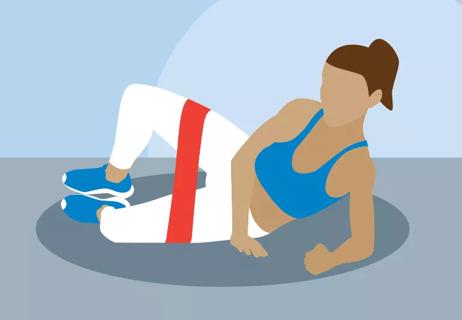Completing as many reps as possible can benefit your mind and body

Sometimes, exercise can feel like a chore. It’s easy to fall into a rut, running the same route every time or pushing play on the same online workouts. It’s hard to find the time to come up with a new workout plan or make the commitment to try a new class.
Advertisement
Cleveland Clinic is a non-profit academic medical center. Advertising on our site helps support our mission. We do not endorse non-Cleveland Clinic products or services. Policy
But when your body gets used to doing the same workout all the time, your progress usually stalls. AMRAP can be a great tool for taking your workouts up a notch without necessarily tacking on extra time.
AMRAP stands for “as many repetitions (or rounds) as possible,” done in a set amount of time. By working against the clock, you naturally push yourself and increase your intensity.
“An AMRAP workout shows you what you can do and takes you out of your comfort zone,” says sports medicine physician Matthew Kampert, DO. “And there are benefits when you do it appropriately and intermittently.”
Sprinkle them into your weekly fitness routine to shake things up. Both your muscles and your mind will thank you. Dr. Kampert explains what AMRAP workouts are like and how you benefit.
What is an AMRAP workout?
AMRAP workouts are timed, high-intensity workouts, much like high-intensity interval training (HIIT). The difference is that there aren’t any set rest breaks like there are in HIIT. In AMRAP, you’re working the entire time and only rest when you really need to — to reset your form or if you get too winded.
The three main components of your AMRAP workout are:
Advertisement
“I view AMRAP as a great tool to have in your toolbox,” Dr. Kampert says. “And you can use that tool in many different ways.”
Adding AMRAP workouts to your fitness routine offers physical and mental health benefits.
AMRAP is a formula for your workout that anyone can use, regardless of your current fitness level. And you can customize it to work toward any type of fitness goal. It can also be done using just your body weight or any equipment you have available.
Are you looking to get stronger? Focus your session on strength training. Add variety (and challenge) using a kettlebell, exercise bands or weights.
Want to get better at cardio or have more endurance? Choose exercises that get your heart pumping, like jumping jacks, high knees or running in place.
No matter your goal, you can work at your own pace while still making progress.
And if you’re new to AMRAP, start slow and focus on the correct form for each exercise.
“Try to stick with basic movements that you’re comfortable with,” Dr. Kampert says. “Do all the movements on their own before you start timing them or using them in circuits.”
If you can’t maintain form throughout the workout, it may be a sign you need to slow down or rest. If you’re unsure of correct form, a personal trainer or fitness professional can help you get started.
Some days, it’s not easy to fit a workout into your schedule. A major advantage of AMRAP is you can get a total body workout in 15 to 20 minutes.
“To work your whole body, you’ll alternate between upper and lower body exercises,” Dr. Kampert says. “Total body workouts can be longer because you’re working all your major muscle groups.”
If you’re only focusing on one area of your body, you can expect your workout to be shorter (five to 10 minutes).
Many of the most popular exercises in AMRAP workouts are functional exercises. This means they mimic movements you perform in daily life, such as bending, rotating, pushing and pulling. Push-ups, squats, rows and lunges are some examples of these types of exercises.
Functional exercises are great multitaskers because they use muscles throughout your body. When you do them at a high intensity for an extended period, you work your heart muscle, too. This means you get both the benefits of cardiovascular exercise and strength training.
“If you’re someone whose exercise has always been strictly steady-state cardio (like running, walking or cycling), AMRAP gives you another dimension of training,” Dr. Kampert explains.
The high intensity helps build strength. The high number of repetitions builds muscular endurance. Put them together and, over time, your muscles won’t tire out as quickly.
Advertisement
Exercise is widely recommended to combat mental health issues. It can improve self-esteem, provide distraction and produce endorphins (hormones that reduce stress and improve mood).
But some research now shows that the higher the intensity, the better for your mental health.
A recent study found both HIIT and moderate-intensity interval training were beneficial for reducing anxiety, stress and depression. But HIIT had a more significant impact on depression. More research is needed to fully understand the mental health benefits of higher-intensity exercise.
Dr. Kampert believes that the competitive nature of AMRAP also plays a role in improving mental health.
“I think there’s a big benefit mentally from getting into an athletic mindset,” Dr. Kampert says.
Competition, even with yourself, can motivate you to continue with an exercise plan, which typically boosts mental health.
It’s easier to stick with an exercise routine when you can see results. When you’ve been doing the same AMRAP workout for a while, you can notice when you’re able to complete more reps or rounds. You can also see how it starts to feel any easier. These shifts indicate progress and can spark your motivation.
“The concept of AMRAP provides extra motivation,” Dr. Kampert notes. “It encourages you to beat your personal best instead of just completing a certain number of sets or rounds.”
Advertisement
For athletes who specialize in certain sports, like martial arts, AMRAP can be designed to provide sports-specific cross-training.
“If you think of sports like wrestling or jujitsu, you don’t know what’s coming at you,” Dr. Kampert says. “And you don’t know how long you’ll have to go all out.”
AMRAP can mimic stresses that your body may face in athletic competition and improve your strength and stamina.
Intense exercise done correctly and safely definitely has benefits. But it also has some downsides, cautions Dr. Kampert.
Common concerns associated with AMRAP workouts include:
Advertisement
“AMRAP shouldn’t be your day-after-day workout because it does put a lot of stress on your body,” Dr. Kampert states. “But you get a lot of bang for your buck, and it’s good to challenge yourself periodically.”
Before beginning any new fitness program, remember to check with your healthcare provider. They can help determine if it’s a good fit for you. If you’re new to working out or just getting back into exercise, consider working with a personal trainer or fitness professional. They can recommend exercises for your fitness level and help you get started with good form.
Learn more about our editorial process.
Advertisement

Kettlebells can amp up your workout game

Exercises to stretch your way to better strength

Find out which workout takes high-intensity training to another level

Losing belly fat can reduce your risk for chronic health conditions — try focusing on a diet high in lean protein, exercising regularly, reducing stress and getting quality ZZZs

It’s best to exercise before or after your fast, instead of during it

Absolutely! In fact, in many ways, exercise is key to recovery

The exercise — which you’ve probably been doing since grade school — can be intimidating, but proper form can help

Cardio is great for improving cognition, but strength and balance training are just as important

Type 2 diabetes isn’t inevitable with these dietary changes

Applying a hot or cold compress can help with pain